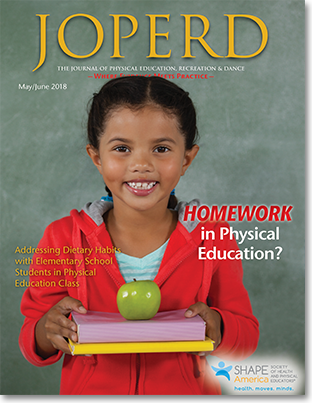 JOPERD Table of Contents
JOPERD Table of Contents
Homework in Physical Education? A Review of Physical Education Homework Literature
Kory Hill

The perceived value of assigning homework as a learning tool has fluctuated from one decade to the next. Historically, social and political forces have influenced the amounts and types of homework assigned to students (Gill & Schlossman, 2004; Maltese, Tai, & Fan, 2012). The often contentious debate about the efficacy of homework persists today. Some have argued that it is a vital learning tool that can help students master necessary content while fostering skills such as time management and self-direction (Bembenutty, 2011). Others, such as Kohn (2006), have maintained that homework leads to a loss of interest, and that it merely forces rote practice while failing to promote higher-order cognitive skills. Kohn further contended that time devoted to homework could be better spent engaging in activities that truly interest students without exacerbating
the achievement gap observed between students who have a lot of parental support versus those who do not (Kohn, 2006). While intense debates regarding homework for academic classes continue, the use of homework in physical education classes has not inflamed such passions. Homework has not traditionally been used as a learning tool in physical education to any significant degree (Mitchell, Stanne, & Barton, 2000). Consequently, the efficacy of physical education homework has received little attention from researchers.
Given the limited amount of time typically set aside for physical education and the increasing need to document evidence of student achievement, some physical educators have proposed an expanded role for homework in physical education (Hill, 2009; Novak & Lynott, 2015; St. Ours & Scrabis-Fletcher, 2013). Many of the characteristics of active homework, that which requires physical activity, are likely to increase physical activity levels.
For example, levels of physical activity tend to increase when there is parental involvement, activity choice, encouragement of extracurricular participation, and the acquisition of motor skills (Baranowski et al., 1997), all of which are characteristics of active homework (M. A. Smith & Claxton, 2003). As more schools incorporate comprehensive school physical activity programs (CSPAPs), there should be more opportunities for physical educators to involve parents and classroom teachers through the assignment of homework that promotes physical activity (Castelli & Ward, 2012).
Physical educators should have as complete an understanding as possible about the current research regarding the use of homework in their discipline. The aim of this article is to explore the efficacy of using homework as a teaching tool in physical education. Reviewed studies address the perceptions and practices of teachers, parents and students related to physical education homework and the influence of homework across multiple learning domains.
To read the rest of this article,
click here to download a pdf.